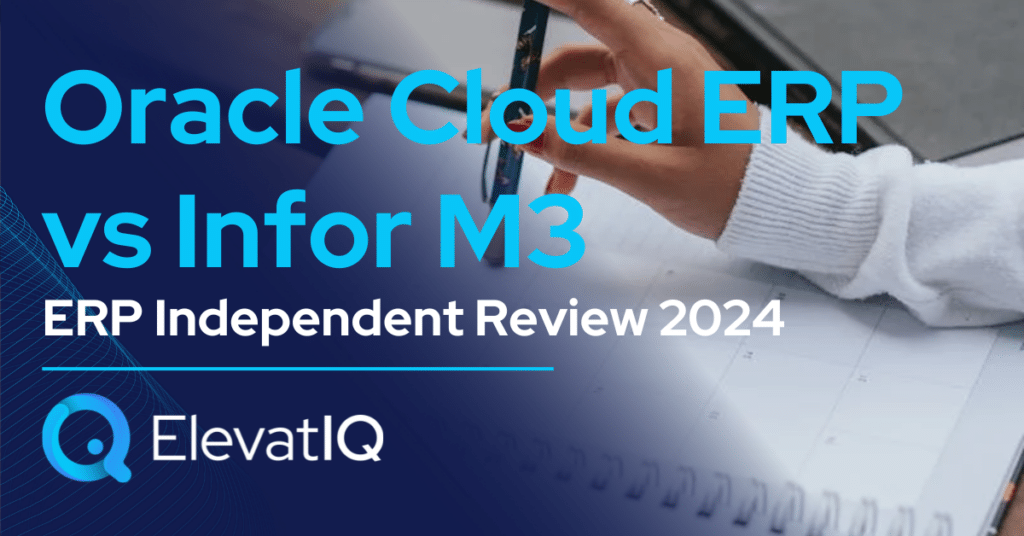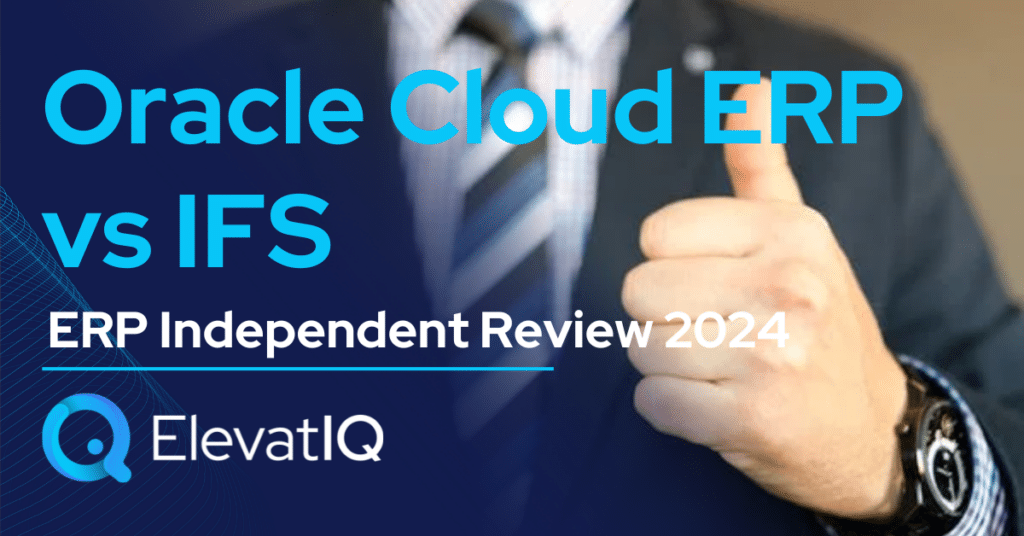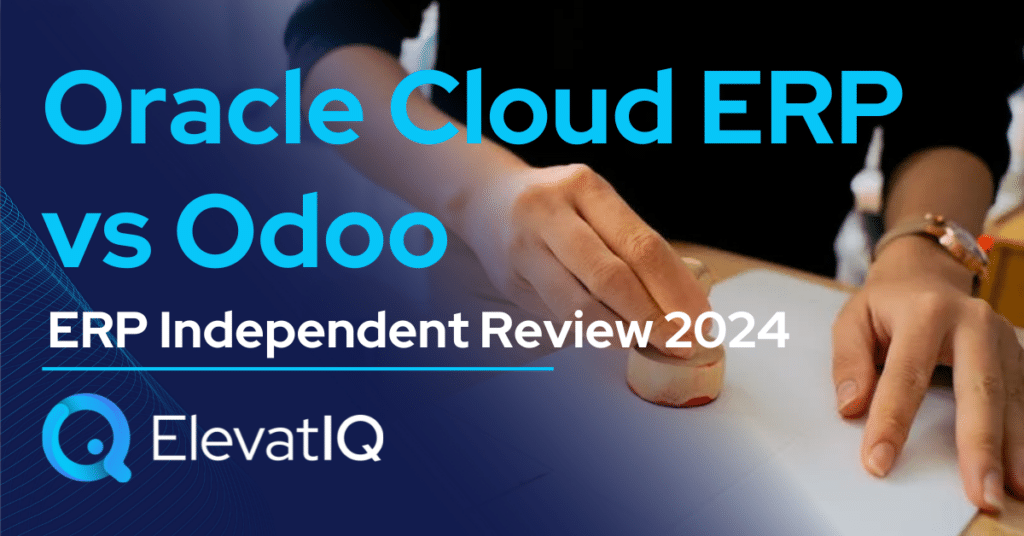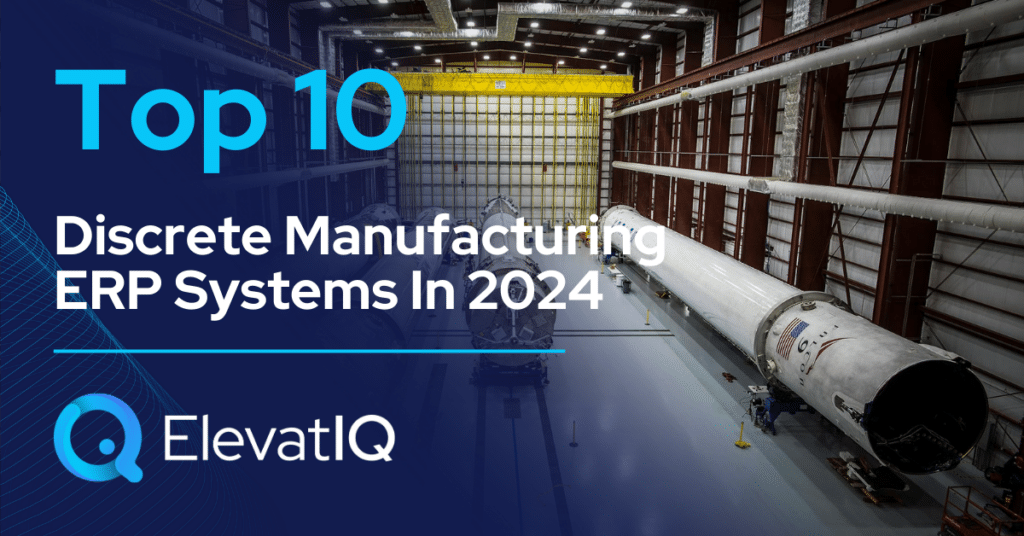Last Updated on March 17, 2025 by Sam Gupta
ERP selection and ERP implementation are significant business initiatives for any organization. It’s a journey that involves numerous steps, each of which plays a critical role in determining the success of your ERP project. Often underestimated in their importance, the initial phases of the ERP selection set the stage for what follows. They form the backbone of your ERP implementation and can either pave the way for a seamless transition or introduce complex challenges that may threaten the ERP project’s success.
This blog delves into the essential ERP selection inadequacies and how they impact ERP implementation. By understanding the intricate link between ERP selection and ERP implementation, you can optimize the value of your ERP system while minimizing potential risks and pitfalls. Therefore, here are the top 5 ERP selection inadequacies and the issues they create for the ERP implementation phase. This explains why ERP selection and ERP implementation can’t be siloed initiatives.
1. Project Initiation
The ERP selection begins with project initiation, marked by a kickoff meeting and the creation of a project charter and stakeholder matrix. This initial phase sets the foundation of the ERP project. The project charter defines the project’s vision, goals, and KPIs for as-is and to-be states. It also establishes a budget and timeline, with the lack of which is a common mistake. Clear vision and goals lead to the creation of a stakeholder matrix, outlining roles, decision-making processes, and responsibilities. Hence, fosters accountability, supported by a core team, steering committee, and communication plan. Once the alignment is achieved, subsequent discovery workshops are conducted to collect and analyze data structures.
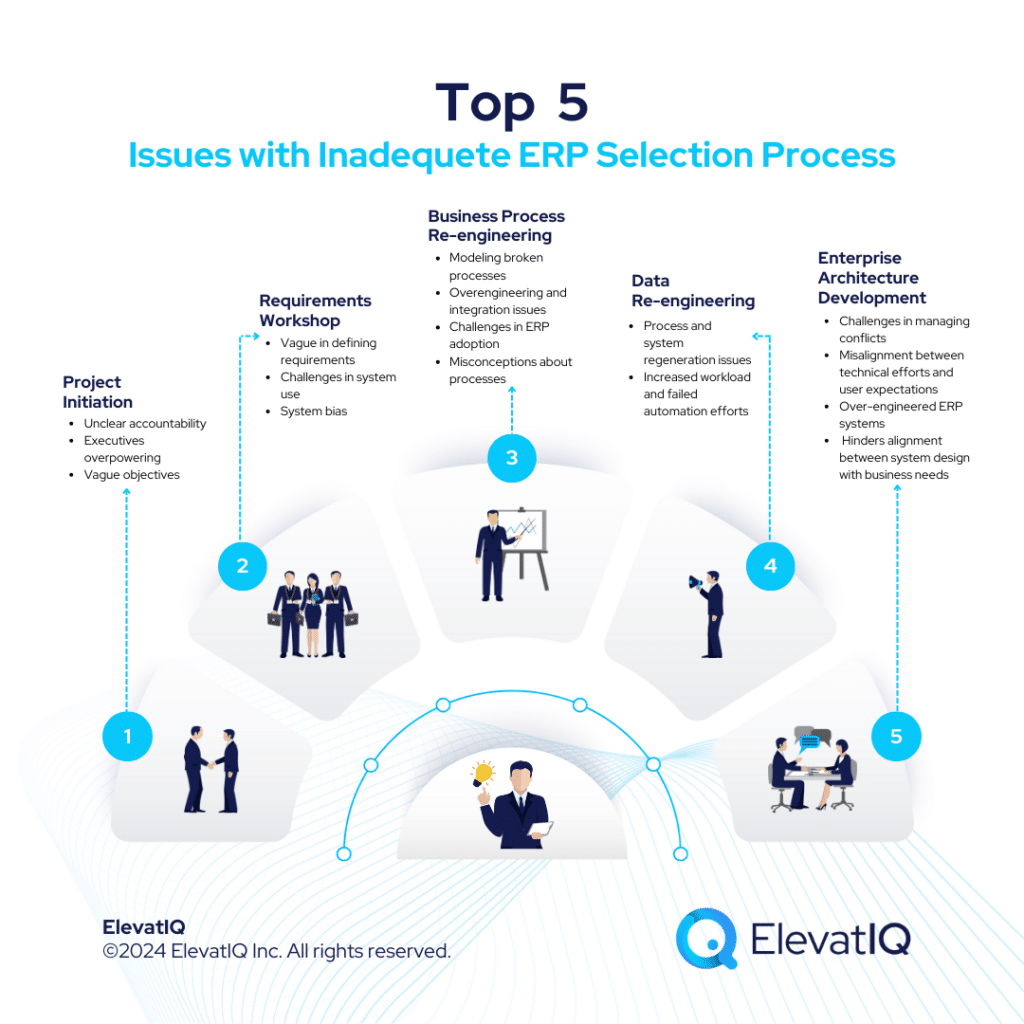
Issues of Inadequate Project Initiation
One of the major ERP selection inadequacies that are persistent in ERP projects is inadequate project initiation. Being the very first step of the ERP project it lays the foundation and can also be the reason for a million-dollar disaster if not done right. Here are some of the issues that inadequate project initiation might create for you:
- Unclear accountability: The lack of clear accountability often stems from potential issues from loud voices or overlooked opinions during decision-making. This increases the risk of undiscovered implications in the later stages of ERP implementation.
- Executives overpowering: Executives overpowering in ERP implementation can lead to uninformed decisions as they may lack a detailed understanding of ground-level issues, particularly causing disruptions and inefficiencies in the implementation process.
- Vague objectives: Vague objectives, such as a generic desire for a “fully integrated system” without specific definitions or budget constraints, can hinder ERP implementation by leading to misunderstandings and unrealistic expectations.

2. Requirements Workshop
After completing the discovery phase, you’ll have a comprehensive set of requirements across various divisions. It’s crucial to assess existing systems to meet these needs and designate future systems for the task. Although, this shapes your enterprise architecture and workflow interactions, some ERP selection processes overlook this. Assuming ERP is a one-size-fits-all solution. Therefore, to avoid this host your requirements where they align, adhering to architectural and master data governance guidelines.
Requirement workshops review each need, ensuring an understanding of the as-is and to-be state. The team defines process boundaries and agrees on critical success factors, serving as a secondary validation to avoid omitting essential requirements. Therefore, critical success factors are critical needs that can make or break your ERP selection and ERP implementation. Organizations often focus on non-critical specifics, diverting from vital elements.
Issues of Inadequate Requirements Workshop
Requirements workshop is the very next step after the discovery phase, which is often overlooked by businesses. If not performed thoroughly, this can turn out to be one of the ERP selection inadequacies that can lead to misalignment with the business need. Therefore, here are some of the potential issues that inadequate requirements workshops might create for you:
- Vague in defining requirements: Lack of expertise in defining requirements for ERP implementation can lead to vague and insufficiently detailed specifications. Critical assumptions can cause issues in system integrations particularly because vague expectations may have diverse interpretations. It may not align with with the specific needs of the business which is the primary objective of any ERP project.
- Challenges in system use and reconciliation: Lack of expertise in identifying critical success factors in ERP implementation can lead to overlooking deeper implications, such as poor data models and financial control issues. It can ultimately cause challenges during system use and reconciliation.
- System bias: Not defining requirements can often lead to system bias in ERP implementation, as individuals may base requirements on prior experiences with different systems. It can potentially overlook the unique aspects of the new model and rendering critical success factors invalid.
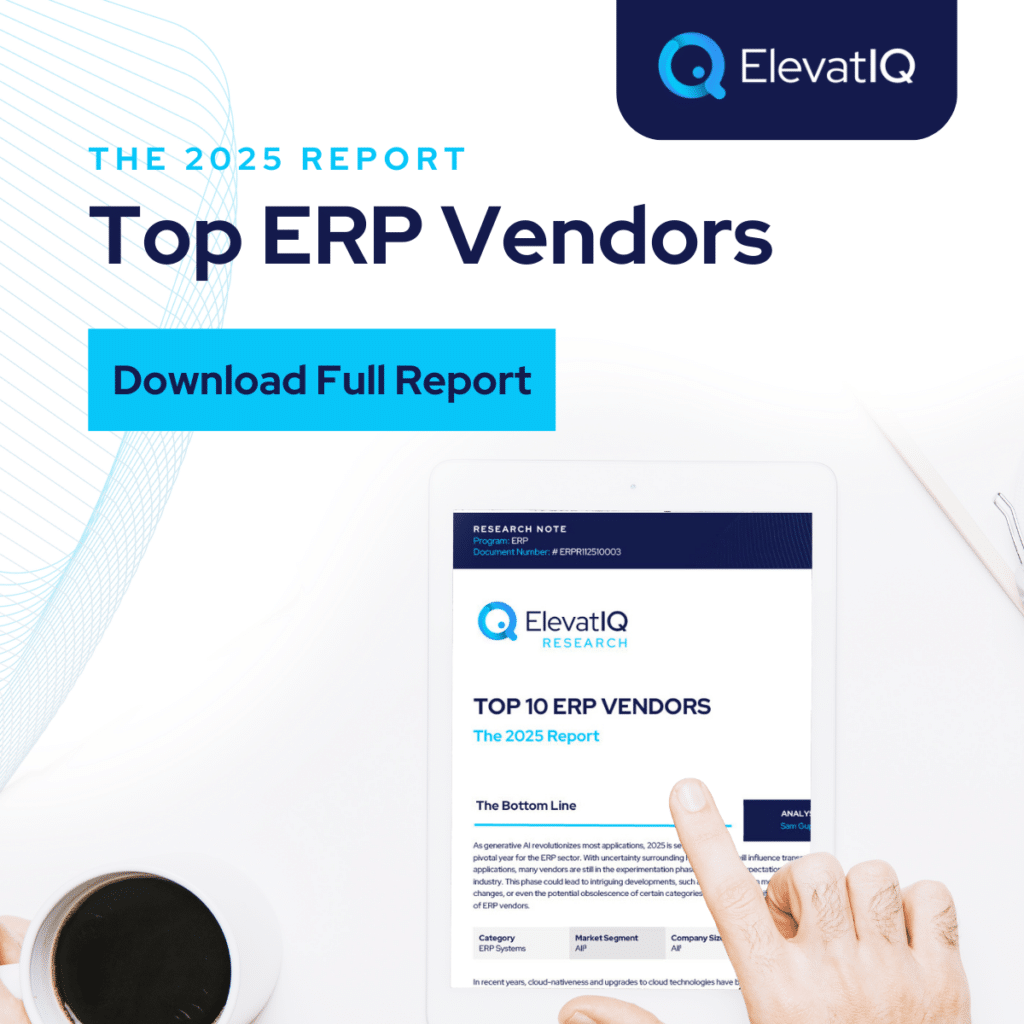
3. Business Process Re-engineering
In ERP selection, business process re-engineering is crucial, mostly influenced by current processes and desired outcomes. Skipping this phase due to cost concerns may often lead to technical overengineering and adoption challenges. An ERP consultant’s expertise is always advisable for assessing processes, even without extensive documentation. Process visualization is vital in this step, considering users’ varied ERP knowledge. This is to ensure clear expectations without contractual commitments.
This phase involves creating BPR maps and aligning processes with enterprise software in a vendor-agnostic way. The goal is to achieve an ERP dictionary-compliant state. Therefore, a detailed analysis is required to determine which processes need restructuring and the impact on information models and architecture. A rollout plan is often needed to follow an iterative approach, allowing for the gradual phase-out of legacy transactions and processes. This step is crucial in balancing stakeholder perspectives. While BPR prevents overengineering and meeting diverse users, the technical team often requires dual maps—user-centric and implementation-focused. Managing the as-is version internally and crafting impactful to-be maps demands specialized ERP implementation experience.
Issues of Inadequate Business Process Re-Engineering
Business process re-engineering is often not focused upon by most companies as it is thought to be a step that doesn’t require much expertise. This often leads to it being one of the ERP selection inadequacies that might result in several ERP implementation issues. Here are some of the issues that you might face:
- Modeling broken processes: Lack of expertise in business processes during ERP implementation can lead to misconceptions, with individuals treating processes as simplistic and overlooking the need for expert knowledge. This results in modeling broken processes as requirements are misidentified.
- Potential overengineering and integration issues: Lack of expertise in persuasion can hinder ERP implementation by impeding the ability to effectively communicate and justify necessary changes. This might lead to resistance from different departments, potential overengineering, and integration issues.
- Challenges in ERP adoption: Relying on technology as a magic solution, without acknowledging the need for proper implementation and alignment with business processes, can lead to significant challenges in ERP adoption.
- Misconceptions about processes: Lack of expertise in data during ERP implementation can lead to misconceptions about unique processes, as processes might be influenced by flawed data. Companies often rely on technical teams for data modeling, but these teams may lack the necessary business expertise, resulting in significant implementation challenges.
4. Data Re-engineering
In ERP selection, data re-engineering is often underestimated by 90% of companies, risking unnecessary complexities. Thorough data analysis and gap analysis are essential to identify areas requiring re-engineering. This process involves crucial layers like master data governance, and understanding intricate relationships between data hierarchies, processes, and system decisions. Maintaining master data integrity, especially when shared externally, is challenging but crucial for successful ERP implementation.
When we talk about master data governance, it goes beyond a system concept. It necessitates the definition of organizational workflows that transcend enterprise boundaries. This involves establishing data origination, maintenance responsibilities, and augmentation procedures. A source of authority matrix for each dataset is crucial in this process. Additionally, the implementation of reconciliation workflows is vital for analyzing transactional data reconciliation across system boundaries, identifying underlying issues in GL reconciliation scenarios, and informing decisions about process and system boundaries during ERP implementation.
Issues of Inadequate Data Re-engineering
ERP selection inadequacies might also occur when data re-engineering is ignored during the selection phase. This might happen due to the preconceived notion that this is a critical step in ERP implementation. It is a debatable topic as some might think this to be a practical decision whereas it might also lead to increased workload in some cases. Here are some issues that might occur due to inadequate data re-engineering:
- Negative impact on process and system regeneration: Confusion between conducting data re-engineering in the ERP selection or implementation phases can be similar “chicken-and-egg who came first” problem. Delaying this critical step until the implementation phase may seem practical due to uncertainties in system selection. However, overlooking data re-engineering during selection can result in surprises, impacting both process and system regeneration, becoming a common challenge in ERP implementation.
- Increased workload and failed automation efforts: Lack of experience in data-centric systems can lead to challenges in understanding and analyzing data flows within ERP implementations. It often results in unintended consequences such as increased workload, failed automation efforts, and compromised customer experience.
5. Enterprise Architecture Development
In ERP selection, developing enterprise architecture is crucial. This step assesses existing and new systems to establish the as-is and to-be states of data flow. It identifies department workflows, user transaction execution, and reconciliation processes to align business and technical teams.
Mapping user and department workflows is a key task in this step. It goes beyond primary system identification, extending to secondary and tertiary systems for root cause analysis. This system-level view is category-focused and independent of specific technologies. The next significant task is high-level design. It delineates component roles, responsibilities, and significant system messages. Unlike detailed technical aspects, it offers a broad view, aiding technical teams in understanding business outcomes. Following this, detailed design takes the spotlight. Technical teams craft specifications based on the high-level design, addressing intricacies such as error handling. This phased approach ensures a comprehensive understanding and alignment between business and technical aspects in the ERP selection phase.
Issues of Inadequate Enterprise Architecture Development
Having an unclearly defined enterprise architecture may often lead to one of the most critical ERP selection inadequacies. This is a common mistake made by businesses during ERP selection. ERP systems may not give the desired results due to the lack of a clear definition of the architecture. Here are some of the issues that might be created due to inadequate enterprise architecture development:
- Challenges in managing conflicts: Lack of experience in diverse ERP systems can hinder implementation, leading to challenges in managing vendor conflicts and balancing the need for both broad and specialized perspectives in the project.
- Over engineer ERP systems: Overengineering the ERP system due to a lack of a clearly defined enterprise architecture and data model can lead to hosting diverse requirements within ERP. This can cause an overload on specific systems (e.g., e-commerce or POS) and hinder the overall understanding of data flow implications across the architecture.
- Misalignment between technical efforts and user expectations: Delaying technical decisions in ERP implementation by deferring architecture development may result in technical teams discovering obstacles in building the model. This is because critical assumptions were not thoroughly examined during the selection phase. It can also lead to a misalignment between technical efforts and user expectations. Users may find the implemented solution does not align with their needs, causing dissatisfaction and potentially requiring significant rework.
- Hinders the alignment of system design with business needs: Lack of business perspective in ERP implementation can lead to a technical-centric focus, causing disinterest among business stakeholders. This hinders the alignment of system design with business needs and may result in implementation challenges.
Conclusion
While paving through the journey of ERP selection and implementation, recognizing the symbiotic relationship between these phases is very important. The decisions made during selection lay the foundation for a successful implementation. Similarly, the presence of one too many ERP selection inadequacies can also lead to failed ERP implementation. The careful alignment of your ERP system with your organization’s needs, the establishment of clear objectives, consensus among stakeholders, and the groundwork of efficient processes and reliable data ensure that the implementation phase is built on a solid base.
On the other hand, underestimating the importance of thorough work during selection can lead to costly and risky challenges during ERP implementation. The realization of this connection underscores the importance of a well-executed selection phase, which, in turn, guarantees a smoother, cost-effective, and less risky implementation process. This list of issues aims to offer you an overview of the interdependence between ERP selection and implementation, for you to discuss further with your independent ERP consultant.




